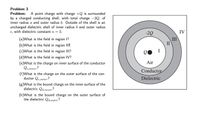Question
Please solve parts d, e, f, g.
Answers for a-c:
a) E=Q/(4πε0r2) for r<a
b) E=Q/(4πε0r2) for a<r<b
c) E=1/(4πε0r2)(-Q/3r2) for b<r<c

Transcribed Image Text:Problem 3
Problem: A point charge with charge +Q is surrounded
by a charged conducting shell, with total charge -2Q, of
inner radius a and outer radius b. Outside of the shell is an
uncharged dielectric shell of inner radius b and outer radius
c, with dielectric constant x = 3.
-2Q
IV
III
I
(a)What is the field in region 1?
(b)What is the field in region II?
(c)What is the field in region III?
I
(d)What is the field in region IV?
Air
(e)What is the charge on inner surface of the conductor
Qe,inner?
(f)What is the charge on the outer surface of the con-
ductor Qe,outer?
Conductor
Dielectric
(g)What is the bound charge on the inner surface of the
dielectric Qa,inner?
(h)What is the bound charge on the outer surface of
the dielectric Qd,outer?
Expert Solution
This question has been solved!
Explore an expertly crafted, step-by-step solution for a thorough understanding of key concepts.
Step by stepSolved in 2 steps

Knowledge Booster
Similar questions
- A.) i. Define the plane polar unit vectors ŕ and 0 and show that they are orthonormal. Determine dr dê and de de ii. Hence show that for the vector r(t) = r(t)ŕ dr · = rî +rðê, d²r and = - dt dt² († − rė²)ŕ + (2ŕė +rë)ê . iii. If a mass m moves in the plane along r(t) = a and (t) = 5t determine the shape of the motion and find its period. B) Show that the motion of an object under the universal gravitational force μη Fg is governed by the radial and angular equations of motion and μ = 0, 2r0+ rö = 0. Setting r(t) =R for some constant R, solve these equations of motion and determine the period of the motion. C) Consider the following non-linear differential equation *+5= x +4. Find the stationary solutions. Expand around each of the stationary so- lutions that you have found, in order to determine if they correspond to stable or unstable equilibria. D) Show that 1 5 E = 2 - 4x is a conserved quantity. Hence draw the phase-space diagram and de- termine for which values of E oscilations…arrow_forwardUse Stokes' theorem to evaluate SF. dr where F = z²î + y²ĵ + xk and C is the triangle with vertices (1, 0, 0), (0, 1, 0), and (0, 0, 1). The unit vector normal is upward. Z -3 2 2 Xarrow_forwardThe figure shows three vectors. Vector A→ has a length of 31.0, vector B→ has a length of 67.0, and vector C→ has a length of 22.0. Find each magnitude and direction. |A→×B→|= ? direction: ? |C→×B→|= ?arrow_forward
- Vector A = 2 +33 and vector B = 51-43 +3k. Part A What is the cross product Ax B? Find the -component. Express your answer as integer ► View Available Hint(s) A × B]x = Submit Part B IVE ΑΣΦ α B Y V Ax By = A Submit T P Σ Previous Answers Φ Ψ Ω Find the y-component. Express your answer as integer ▸ View Available Hint(s) € n 6 T φ - ΑΣΦ ħ 0 χ E • * Incorrect; Try Again: 5 attempts remaining A component of a cross product does not equal the product of the respective vector components. You may need to review The Vector Cross Product. You may want to review Hint 1. How to approach the problem. K y @ 2 μ ? ?arrow_forwardex1arrow_forwardQuestion 4 Show that ǝ\rho (x, t) Ət + d√(x, t) dx = 0.arrow_forward
arrow_back_ios
arrow_forward_ios